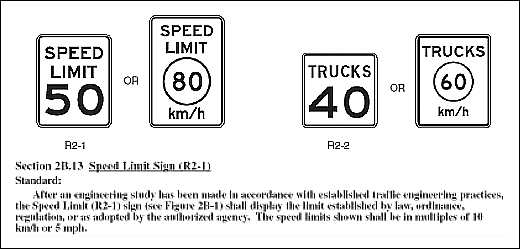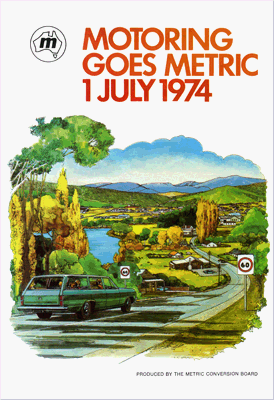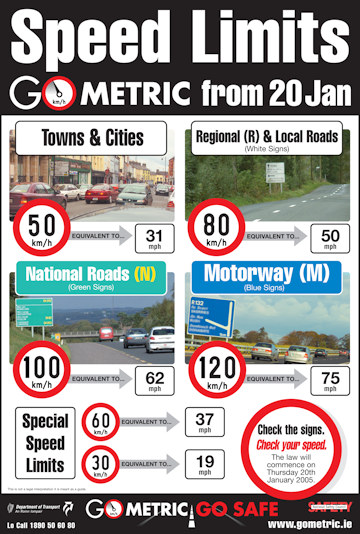Britain is not unique in having faced the challenge of switching from imperial to metric road signage. Commonwealth countries such as Australia and Canada successfully changed their road signage and speed limits in the 1970s. In 2005, the Republic of Ireland completed its transition. In contrast the United States has made relatively little progress.
Australia
A comprehensive metrication programme took place in Australia in the 1970s. One key element in the changeover was the change of road signage and speed limits. The Australian population – like that of Britain – was used to imperial units but the changeover took place safely and smoothly.
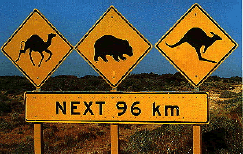
The following is an extract from an official government report (Wilks, K.J., 1992: Metrication in Australia, Department of Industry, Technology and Commerce (DITAC), Commonwealth of Australia, ISBN 0-644-24860-2)
“One of the most important and publicly visible of the metric changes was the change in road speed and distance signs and the accompanying change in road traffic regulations. M-day for this change was 1 July 1974 and, by virtue of careful planning, practically every road sign in Australia was converted within one month. This involved installation of covered metric signs alongside the imperial sign prior to the change and then removal of the imperial sign and the cover from the metric during the month of conversion.”
Except on bridge-clearance and flood-depth signs, dual marking was avoided. Despite suggestions by people opposed to metrication that ignorance of the meaning of metric speeds would lead to slaughter on the roads, such slaughter did not occur.
A Panel for Publicity on Road Travel, representing the various motoring organisations, regulatory authorities and the media, planned a campaign to publicise the change, believing that public education, not the confusion that would result from dual sign posts, would be the most effective way of ensuring public safety. The resulting publicity campaign cost $200 000 and was paid for by the Australian Government Department of Transport.
In addition, the Board produced 2.5 million copies of a pamphlet, “Motoring Goes Metric“, which was distributed through post offices, police stations and motor registry offices.
“For about a year before the change, motor car manufacturers fitted dual speedometers to their vehicles and, after 1974 all new cars were fitted with metric-only speedometers. Several kinds of speedometer conversion kits were available. As a result of all these changes, conversion on the roads occurred without incident.”
Canada
In a similar way Canada managed to change its roads to metric without incident. Sensibly the sale of petrol changed from imperial gallons to litres at the same time; thus avoiding the fuel consumption mess that exists at present in Britain.

Like Australia, a very rapid conversion was achieved. Speed limit signs were converted at the Labor Day weekend and from that point all new cars were required to indicate speeds in km/h and show distances in kilometres. Distance signs were converted over the following months. Cost savings were achieved by using vinyl overlays (decals).
Ireland
The Republic of Ireland’s metrication programme started much later than that of the UK. However by completing the metrication of its roads in January 2005, it has left the UK well behind.
In contrast to Canada, which started its conversion programme with speed limits, Ireland made changes of speed limits the final stage in the changeover.
Ireland replaced imperial distance signage over a period of 10 years. Since the lifetime of most road signs is also 10 years this meant that there was virtually no cost to this conversion.
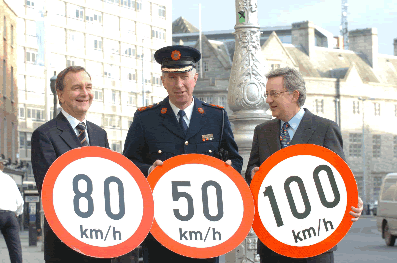
The final stage of the programme was to convert the speed limits on 20 January 2005. The Irish Department of Transport took the opportunity afforded by metric conversion to comprehensively review speed limits. As a result, the speed limits should be better tuned to local traffic conditions and hence helping road safety.
The key to a successful changeover was believed to be a very rapid conversion of the actual signs preceded by a blitz of information and publicity in the two weeks preceding the change. Drivers were therefore left in no doubt as to what was happening and were warned that ignorance or confusion about the new limits would not be accepted by the police as an excuse for breaking the new limits.
Like Australia and Canada, the changeover passed without incident.
RTE Archives – 2005-01-20
Motorists in Ireland adapt to the introduction of speed limits set in kilometres per hour rather than miles.
Mind Your Metric Speed 2005
USA
The fact that the United States has largely not adopted metric units has been used as an excuse by some people in Britain to do nothing. However it is ironic that the United States has less restrictive rules for using metric distance signs and speed limits than Britain.
The following illustration from the US “Manual on Uniform Traffic Control Devices for Streets and Highways” (Federal Highways Administration, 2003) shows how metric speed limits and signs are permitted as alternatives to those based on miles per hour.
